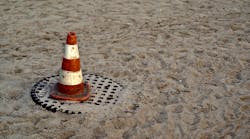Headworks, also known as the gateway to wastewater treatment, is where the wastewater enters the wastewater treatment plant (WWTP). It generally removes large debris and coarse particles like grit and sand. This article explains what headworks are, why headworks are important, and the technologies used for headworks in a WWTP.
What is headworks in a wastewater treatment plant?
The headworks is the first step in wastewater treatment. It contains bar screens to block large solids from entering the system and grit chambers to remove heavier particles such as sand and gravel. Besides flow controls and pumps, a headworks in some WWTPs, depending on the plant’s needs, also contains a comminutor to shred solids into smaller pieces and an equalization tank to stabilize the flow rate.
Where in the wastewater process is headworks equipment found?
It is found right after the wastewater collection chamber, also known as the sewer. Wastewater from different sources collect in the sewer and the sewer water flows into the headworks.
The Baltimore City Department of Public Works has The Headworks Project which contains various facilities including a flow entry. This contains large collection conduits to deliver the incoming wastewater to the coarse screen facility in the headworks. This headworks system also contains another facility, the influent pumping station that controls the flow of the wastewater to the fine equalization tanks or to the fine screen facility.
What is headworks equipment in a wastewater plant used for?
Headworks equipment is used to remove large debris such as sticks, grit, and sand before the wastewater travels downstream for treatment. This is useful to prevent damage to the downstream equipment.
By also removing grit and sand, headworks equipment prevents clogging, blockage and wear and tear of pumps, pipes, and other components of the WWTP. In some WWTPs, ventilation systems or the use of odor-eliminating chemicals are also a component of a headworks to control odor from decomposing organic matter in the wastewater.
What waste is commonly found in headworks and what happens to them?
Wastes commonly found in headworks:
- Large objects including plant debris
- Sand, grit, and gravel
These wastes are collected in the headworks and then removed. Depending on the regulations, these wastes could be further treated before they are disposed of in landfills.
What happens to the wastewater passing through headworks?
In headworks, the incoming wastewater goes through bar screens to remove large particles including sticks and plastics. The screen could be a mesh or perforated plates to retain large objects from the wastewater. The wastewater also goes through grit chambers or vortex grit removal systems where heavy particles like sand and gravel settle to the bottom and the wastewater flows out.
What happens to the wastewater after headworks?
After passing through the headworks, the wastewater then enters the subsequent treatment processes in a WWTP. This includes primary, secondary, and in some WWTPs, tertiary treatments to remove chemicals including organic matter and disease-causing microorganisms from the water. In some wastewater treatment facilities, the wastewater moves from the headworks to the primary treatment facility by gravity. In this case, the headworks is at a higher elevation and thus upstream of the subsequent treatment facilities and therefore, the flow moves by gravity rather than pumping force to save energy.
Is headworks different from wastewater screening?
The basic principle of screening is the same for headworks and for wastewater screening – i.e., the removal of particles using a screen. However depending on the wastewater treatment facility, headworks screens could remove different types of particles than wastewater screens.
Headworks screening removes bigger and coarse particles such as plant debris, plastic, sand, grit, and gravel from the incoming wastewater before the wastewater flows to the other treatment processes in the WWTP. These bigger and coarse particles collect in the water from originating sources and as the water flows enroute to the sewer. Wastewater screening, on the other hand, removes smaller particles that are not trapped by coarse screening.
Some headworks contain both coarse screening and fine screening facilities. For example in The Headworks Project in Baltimore, MD, there is a coarse screening facility for removing large particles and there is also a fine screening facility for removing smaller particles. In some WWTPs, fine screening is also a treatment process separate from the headworks and uses filtration to remove chemicals including pollutants.
Challenges for headworks in wastewater treatment systems
If the headworks fails due to clogging or high inflow of the incoming wastewater, which happens in flooding, untreated sewage can flood the surrounding areas. This is referred to as a combined sewer overflow (CSO) because the sanitary wastewater is combined with the stormwater flows.
Some of the options to consider to avoid this scenario includes increasing pump capacity to meet the needs of increased water inflow during floods, alternating power supply sources for the pumps, and installing secondary controls such as float switches to use during a power outage.
What technologies are used for headworks in wastewater treatment plants?
These technologies include the use of a high-efficiency grit-removal system for effective grit capture. A study recommended the need to target grit below the 106 micron size to avoid operational challenges. Another study recommended physical measurements of grit, including size and settling velocity to develop a tailored solution for grit removal.
Besides bar screens, grit chambers, and communitors, other technologies used for headworks in WWTPs are:
- Aerated grit removal: These separate smaller organic particles from the water.
- Flow control devices: These include flume and weirs.
The use of technologies in headworks varies from one WWTP to another and is based on the unique operational requirements of the plant.
Advancement in headworks technologies
Advancements in headworks technologies include automated screens with odor control and ultrasonic sensors for precise flow measurement. Other advancements include:
- The use of odor-control bio-trickling filter systems to effectively remove hydrogen sulfide from the influent and to control foul air from the headworks.
- Pipeline improvement to accommodate the movement of the influent wastewater into the headworks. An example is the pipeline design and construction by the San Francisco Public Utilities Commission to relieve stresses on the pipelines and their supporting structures.
Headworks, although not often talked about, are integral to the proper functioning of the WWTPs because they remove large and coarse debris to prevent damage and clogging of the equipment. Proper maintenance of the headworks can thus significantly reduce the operational costs and maintain the efficiency of the wastewater treatment processes.
Take a quiz on headworks for wastewater systems
About the Author
Saleha Kuzniewski
Saleha Kuzniewski, Ph.D. has authored several publications in the fields of scientific research, biotechnology, and environmental regulations. She is the winner of the 2023 Apex award for publication excellence. She is also the founder of Environmental Remediation & Innovations, LLC. Kuzniewski can be reached at [email protected].


